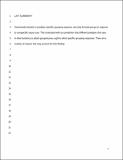Files in this item
Gammarus pulex show a grouping response to conspecific injury cues but not to predator kairomones
Item metadata
| dc.contributor.author | Smith, Lynsey | |
| dc.contributor.author | Webster, Michael Munro | |
| dc.date.accessioned | 2016-05-28T23:32:33Z | |
| dc.date.available | 2016-05-28T23:32:33Z | |
| dc.date.issued | 2015-07 | |
| dc.identifier | 191337029 | |
| dc.identifier | 080a4037-23e3-495d-a275-32d0c2db2281 | |
| dc.identifier | 84941636270 | |
| dc.identifier | 000358171600031 | |
| dc.identifier.citation | Smith , L & Webster , M M 2015 , ' Gammarus pulex show a grouping response to conspecific injury cues but not to predator kairomones ' , Behavioral Ecology , vol. 26 , no. 4 , pp. 1188-1195 . https://doi.org/10.1093/beheco/arv071 | en |
| dc.identifier.issn | 1045-2249 | |
| dc.identifier.other | ORCID: /0000-0001-9597-6871/work/60427828 | |
| dc.identifier.uri | https://hdl.handle.net/10023/8893 | |
| dc.description.abstract | Many species gain protection from predators by forming groups, but there is also evidence that some predators are better able to detect or more likely to attack grouped prey. Given this, it might pay prey to be flexible in their group behavior, forming groups on detecting certain predators, but dispersing when detecting others. In the first of 2 experiments, we found that flounders (Platichthys flesus) were more likely to attack larger groups of gammarids (Gammarus pulex) than smaller ones, whereas sticklebacks (Gasterosteus aculeatus) showed no such bias. This gave us the opportunity to test the idea that prey might show predator-specific grouping responses. Accordingly, our second experiment compared the grouping behavior of gammarids exposed to kairomones from either of the 2 predators, to conspecific injury cues (a nonspecific predation cue), to combinations of predator kairomone plus conspecific injury cues and finally to 2 control treatments. We predicted, based on our first experiment, that the gammarids would disperse in response to flounder kairomones, and group more cohesively in response to stickleback kairomones and conspecific injury cues. In fact, only the treatments including conspecific injury cues elicited a grouping response in the gammarids, whereas predator kairomones alone had no effect whatsoever on group cohesion or dispersal. We discuss possible explanations for these findings and briefly consider other systems that might be better suited to exploring predator-specific antipredatory grouping behavior. | |
| dc.format.extent | 8 | |
| dc.format.extent | 343445 | |
| dc.language.iso | eng | |
| dc.relation.ispartof | Behavioral Ecology | en |
| dc.subject | Alarm substance | en |
| dc.subject | Antipredator | en |
| dc.subject | Collective response | en |
| dc.subject | Predator-prey | en |
| dc.subject | Selfish herd | en |
| dc.subject | Schreckstoff | en |
| dc.subject | QH301 Biology | en |
| dc.subject | QL Zoology | en |
| dc.subject | Animal Science and Zoology | en |
| dc.subject | Aquatic Science | en |
| dc.subject | Ecology, Evolution, Behavior and Systematics | en |
| dc.subject.lcc | QH301 | en |
| dc.subject.lcc | QL | en |
| dc.title | Gammarus pulex show a grouping response to conspecific injury cues but not to predator kairomones | en |
| dc.type | Journal article | en |
| dc.contributor.institution | University of St Andrews. School of Biology | en |
| dc.contributor.institution | University of St Andrews. Centre for Social Learning & Cognitive Evolution | en |
| dc.contributor.institution | University of St Andrews. Centre for Biological Diversity | en |
| dc.identifier.doi | https://doi.org/10.1093/beheco/arv071 | |
| dc.description.status | Peer reviewed | en |
| dc.date.embargoedUntil | 2016-05-29 |
This item appears in the following Collection(s)
Items in the St Andrews Research Repository are protected by copyright, with all rights reserved, unless otherwise indicated.

